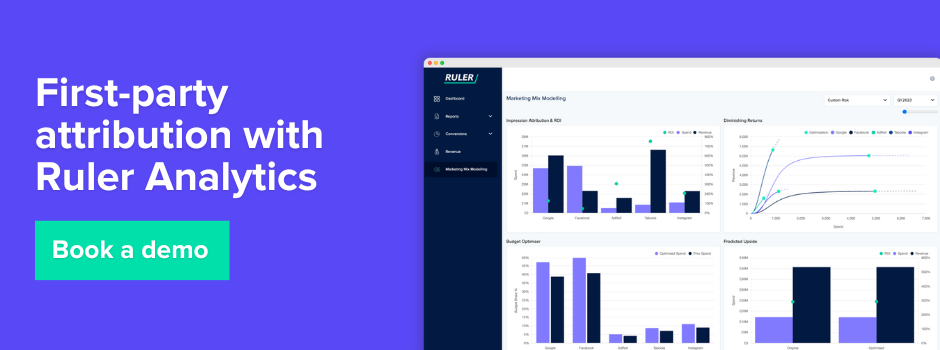Eliminate data silos and reveal what drives real revenue with a first-party data strategy.
The digital advertising ecosystem is undergoing a seismic shift as third-party cookies crumble under the weight of growing privacy concerns.
Major browsers like Safari and Firefox have long blocked them by default, and now even Google Chrome – the final stronghold – is following suit.
Apple’s iOS privacy updates have further tightened the screws, giving users more control over their data and making cross-site tracking significantly harder for marketers.
Why does this matter? Because third-party cookies have been the backbone of digital marketing, fueling everything from retargeting ads to multi-touch attribution.
Without them, marketers face serious challenges in tracking user behavior, measuring campaign performance, and delivering personalised experiences at scale.
But where one door closes, another opens.
First-party data – information you collect directly from your audience – offers a path forward.
Not only is it privacy-compliant, but it also unlocks deeper insights and more durable customer relationships.
In this post, we’ll walk through four essential steps to set up a first-party data strategy that keeps your marketing sharp in a post-cookie world.
We’ll discuss:
💡 Pro Tip
Ruler’s first-party tracking enables the capture of UTMs, click IDs, page views, and referrers. These data points are tied to user conversions – calls, chats, or forms – and stitched into your CRM pipeline. That connection provides marketers with actionable insight into which channels and campaigns are driving real, closed/won revenue.
Book a demo to start your first-party data strategy
So, what exactly is a first-party data strategy, and why is it becoming the new gold standard for marketers?
At its core, a first-party data strategy is about collecting and leveraging the data your audience willingly shares with you.
Related: First-party data: What is it and how to collect it
This includes everything from UTM parameters that track campaign sources, to click IDs, form submissions, call tracking logs, e-commerce transactions, and even survey responses.
A well-implemented first-party tracking setup ensures every conversion is logged and tied to identifiable user behavior, down to email addresses or call metadata, providing an incredibly granular view of your customer journey.
This is fundamentally different from second- or third-party data.
Second-party data is someone else’s first-party data that you purchase or share through partnerships.
Third-party data, on the other hand, comes from aggregators who collect it indirectly from various sources, often without the explicit consent of the end user.
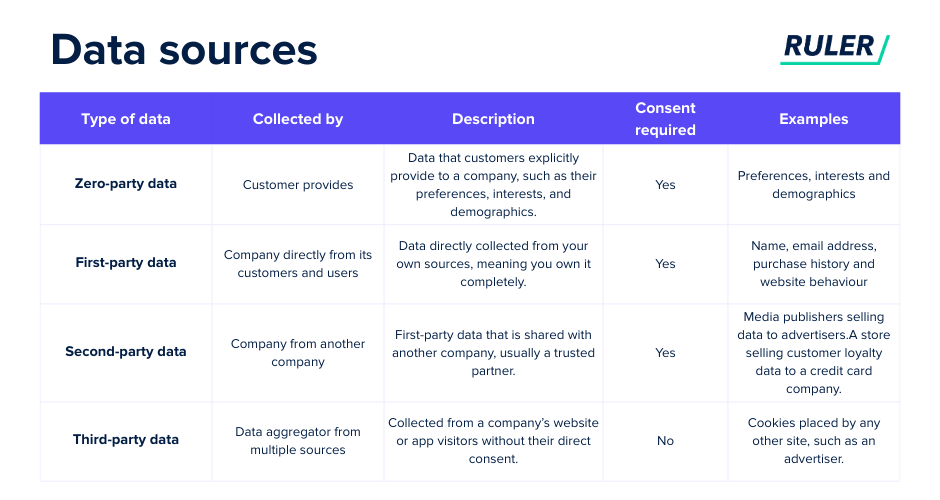
That difference in provenance is key – because first-party data is collected directly from your audience, it’s not only more compliant with evolving privacy regulations, but also far more accurate and relevant.
The biggest advantage? Ownership. While you can’t truly own someone’s personal information, first-party data is the closest you’ll get.
You control how it’s collected, where it’s stored, and how it’s used.
That level of ownership means better targeting, stronger personalisation, and deeper insights, all of which translate into more meaningful customer relationships and smarter marketing decisions.
A first-party data strategy is non-negotiable in today’s digital landscape for several crucial reasons, especially as privacy regulations tighten and third-party data and industry standard tools like GA4 becomes less reliable:
If there was ever a time when marketers could afford to rely on third-party data, that era is officially over.
A first-party data strategy is no longer a “nice-to-have”. It’s a business-critical requirement in today’s privacy-first digital environment.
The shift started with the General Data Protection Regulation (GDPR) in the EU, which fundamentally changed how businesses handle user data.
GDPR mandates that you must not only get explicit consent from users before collecting their data, but also be transparent about why you’re collecting it and how it will be used.
That set a new global benchmark for data privacy, and other regions quickly followed suit.
California’s Consumer Privacy Act (CCPA), while different in scope and enforcement, introduced similar obligations for businesses operating in the U.S. – including the right for consumers to know, access, and delete the data companies hold on them.
These laws aren’t just legal hurdles. They’ve reshaped consumer expectations.
Users now expect to be in control of their data, and they’re more willing to engage with brands that are transparent and respectful of that control.
First-party data fits squarely into this new paradigm. It’s permission-based, collected directly from your audience, and inherently aligned with modern compliance standards.
As privacy regulations advance, the technical landscape of digital advertising is becoming increasingly fragmented.
A major turning point came in 2021 with Apple’s iOS 14.5 update, which introduced App Tracking Transparency.
This gave users the ability to opt out of cross-app tracking, and the response was overwhelming – more than 80 percent of users chose not to be tracked.
As a result, platforms like Meta saw a sharp decline in the effectiveness of third-party cookies for tracking view-through conversions, where users see an ad but don’t click before converting.
Related: What does the future hold for third-party cookies?
This change created substantial blind spots in performance measurement and attribution.
Advertisers now struggle to quantify the true impact of campaigns, and that lack of visibility ripples through algorithmic optimisation.
With fewer data signals to work with, ad platforms can no longer accurately target the most relevant audiences or optimise delivery in real time.
Google Chrome is also moving to phase out third-party cookies entirely, giving users more control over their online footprint and pushing marketers to rethink their entire data infrastructure.
Even Google Analytics, long the go-to platform for digital measurement, has its own limitations that highlight the urgency of adopting a first-party data strategy.
Related: 8 limitations of Google Analytics 4 and how to overcome them
GA4 applies data sampling and thresholding, particularly when working with small audience segments or filtered views. This often results in incomplete or distorted insights that can misguide decision-making.
The tool also leans heavily on modeled data through machine learning, especially when it comes to predicting user behavior or conversions.
But that modeling relies on aggregation, not individual-level tracking, which means you miss out on understanding the specific touchpoints that drive outcomes like form submissions, phone calls, or purchases.
To make matters more complicated, GA4’s attribution modeling is limited. With only two models available and a 90-day lookback window, you’re left with a narrow view of what’s influencing your conversions.
Related: Google Attribution — how to access, compare, & improve your attribution
That’s not enough to build a reliable, full-funnel strategy.
All of this points to one thing. If you want data that’s complete, accurate, and under your control, a robust first-party data strategy is no longer optional.
It’s the only way to ensure you’re making decisions based on insights you can trust.
💡Pro Tip
GA4’s gaps, like limited user tracking, short attribution windows, and missing impressions, make it tough to connect marketing to revenue. We fill those gaps with first-party data, media mix modeling, and incrementality testing for clearer performance insights.
See how it all fits together in our measurement framework
An effective first-party data strategy is built on a foundation of clean, connected, and contextual data. It involves bringing together siloed data sources, enriching them with meaningful attributes, and aligning them to actual revenue outcomes.
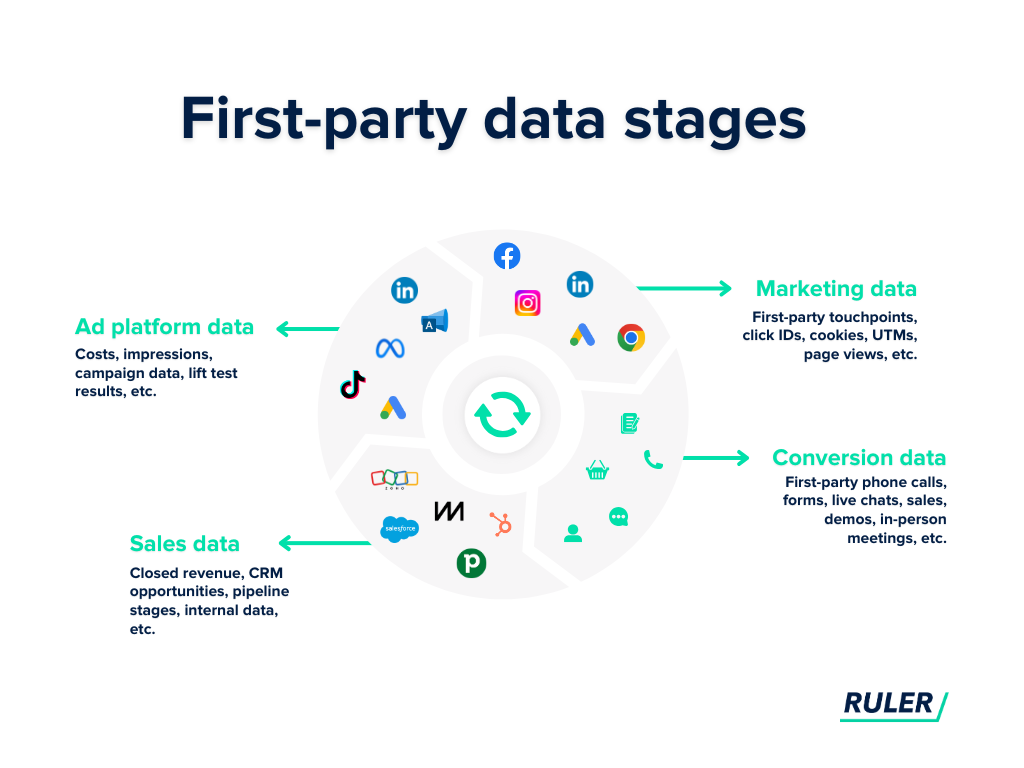
The goal is to create a unified, actionable view of each customer across the entire journey. While there are many ways to approach this, here’s how we structure our own strategy, broken down into four key components.
Every solid first-party data strategy starts with accurately capturing where your visitors are coming from and what they do before they convert.
This is foundational, because if you can’t reliably track the origin of your leads or customers, it’s impossible to understand what’s working and where to invest your budget.
As earlier mentioned, Google Analytics does capture some first-party information, but it’s limited.
The problem is that GA4 aggregates data, applies sampling, and does not retain personally identifiable information.
While it can show you trends in traffic and conversions, it lacks the granularity needed to link specific users to specific touchpoints, especially across sessions or devices.
To build a truly useful view of marketing source data, you need to track user interactions at an individual level, and persist that data across the full customer journey. That means capturing key identifiers like:
To go deeper, we use custom first-party tracking tags through Ruler Analytics.
These tags collect user-level data points like UTM parameters, click IDs, cookies, and page views.
When stitched together, they form a full picture of each individual journey, even across multiple visits.
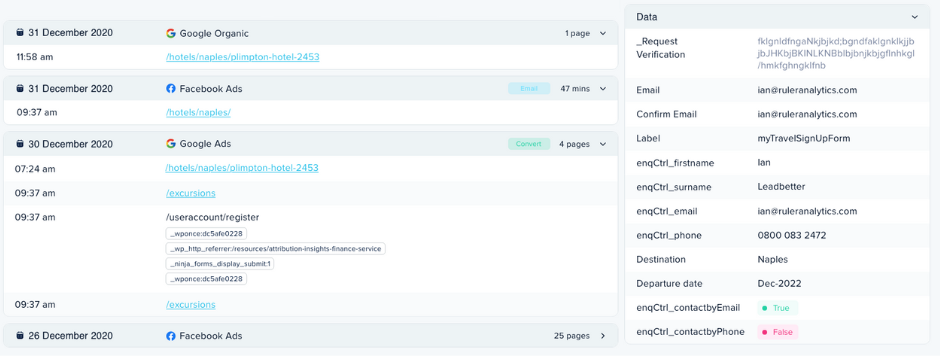
This allows you to understand how specific marketing channels are influencing real user behavior, not just general traffic trends.
💡 Pro Tip
Effective tracking of individual user journeys forms the backbone of a solid first-party data strategy. See how Ruler makes this possible and start planning your own approach. Just book a demo to get started.
Once you’ve established a solid foundation of marketing source data, the next step is capturing conversion data, and most importantly, tying it back to the specific marketing interactions that drove it.
A “conversion” can mean many things: a form submission, a phone call, a live chat interaction, or even an offline event like a product demo or signed contract.
The problem is that traditional analytics tools like GA4 often fail to give you the full picture.
GA4 is built for tracking digital interactions, not actual people.
It can register that a form was submitted, but it can’t tell you who submitted it, or what happened to that lead after the form was completed.
A core issue is that GA4 doesn’t track personally identifiable information (PII).
It can’t store names, email addresses, phone numbers, or any other identifiers that help you tie the conversion back to an individual user and their full journey.
So when someone converts, especially in B2B or high-value B2C contexts where the sales process continues offline, you lose the ability to attribute that outcome to your marketing efforts.
With Ruler’s first-party tracking in place, you can link every conversion to a full pre-conversion journey.
When someone becomes a lead, that data – along with all the associated marketing touchpoints – is sent to your CRM or internal tools.
Related: How Ruler integrates your sales, marketing and customer data
This allows you to accurately track each lead’s origin and understand the true value of your channels and campaigns.
After capturing conversion data and tying it to marketing touchpoints, the next step is to follow that lead through the sales funnel and link it to real revenue.
As leads move through your CRM pipeline, their marketing data stays with them. This lets
you identify patterns and drop-offs throughout the funnel.
For example, you might discover that Meta ads generate a high volume of leads, but those leads stall before becoming customers.
Conversely, a Google campaign might generate fewer leads, but with a much higher close rate.
Or maybe a specific blog page is consistently driving high-revenue opportunities, suggesting it could be replicated or expanded.
With this closed-loop view, you can go beyond basic metrics like cost-per-lead and start optimising for true revenue impact.
You can also sync this data back to ad platforms to refine audience targeting.
Instead of relying on generic retargeting campaigns, you can build custom audiences based on CRM stages or repeat purchase behaviors.
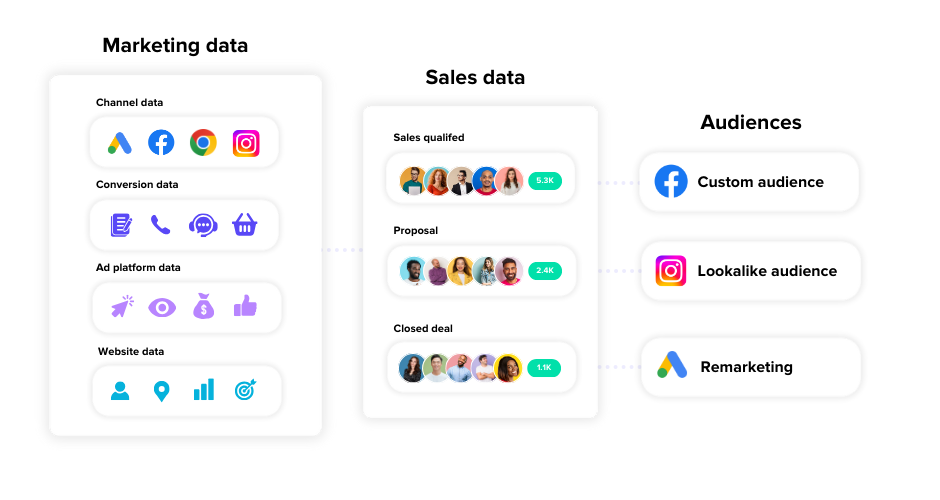
Imagine sending users at the “Proposal/Negotiation” stage into a Meta custom audience to find lookalikes. Or pushing high-value customers into a remarketing campaign with tailored upsell offers.
This is where your first-party data starts to drive real growth.
The final step is integrating your media spend to understand what you’re actually getting for your marketing dollars.
Ad platforms like Meta and Google often operate in silos and use their own attribution models, which can lead to inflated or duplicated results.
If a user sees a Instagram ad but converts later through Google, both platforms might claim credit.
By bringing in your cost data and linking it to your unified first-party tracking, you can calculate real metrics like blended ROAS, customer acquisition cost, and lifetime value.
This helps you make better decisions on budget allocation by removing platform bias and revealing the true performance of each channel.
First-party data is a powerful foundation.
It gives you clean, consented, and high-fidelity insights into how users interact with your brand.
But it’s not the full picture.
By design, deterministic tracking captures actions that can be directly observed and tied to an individual, like clicks.
But it falls short in environments where engagement doesn’t rely on clicks
Think about platforms like TikTok and Instagram.
These are inherently impression-led channels.
Users scroll, watch, absorb – but rarely click. And that’s not a flaw; that’s just how these platforms work.
They influence through exposure, not interaction.
If you’re only looking at deterministic signals, you’re likely missing the impact these upper-funnel campaigns have on driving future conversions.
Someone might see your product on TikTok, remember it days later, and then Google your brand and convert.
Deterministic tracking will credit that conversion to brand search, not to the ad that originally sparked interest.
That disconnect leads to undervaluing key touchpoints and, ultimately, misallocating budget.
Where deterministic data doesn’t exist, such as unclicked impressions, we use probabilistic models to fill in the gaps.
Related: Deterministic vs probabilistic: Why you need both models in marketing
Ruler’s DDA + Impression Model blends click-based (deterministic) data with impression-led (probabilistic) inputs. It borrows from marketing mix modeling principles to assign weightings across all touchpoints, not just those with direct actions.
Related: The role of impression attribution in marketing measurement
Instead of overvaluing the last click, it redistributes credit across the full journey, ensuring platforms like display and social get the attribution they deserve.
The model can also rebalance how budget is attributed, shifting weight away from channels like direct or brand search and toward the campaigns that actually seeded demand.
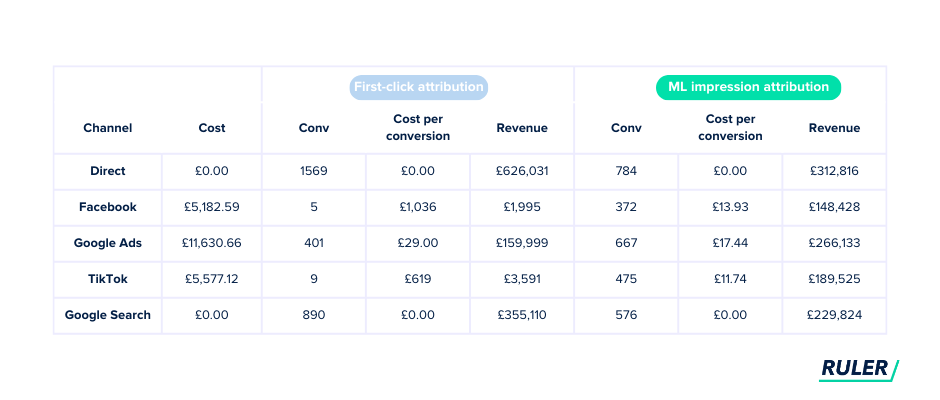
For companies not yet ready for a full-scale MMM setup, pre-built, industry-specific models like this offer a practical, scalable way to get started.
As third-party cookies disappear and analytics tools become more restrictive, relying on fragmented, incomplete data is no longer sustainable.
A strong first-party data strategy gives you the control, accuracy, and depth needed to truly understand customer journeys, measure what’s working, and confidently scale your marketing.
With probabilistic modelling, you can fill in the gaps that deterministic tracking may miss, ensuring all your channels are accounted for.
At Ruler, we help you connect the dots between anonymous visitors, marketing touchpoints, and closed revenue. Our impression model blends click-based (deterministic) data with impression-led (probabilistic) inputs to bridge those gaps.
From capturing rich source data to linking conversions, sales, and costs, our platform brings everything into a single, actionable view, allowing you to make smarter decisions and prove the value of your marketing.
Book a demo with our team to see how Ruler can help you turn disconnected data into a unified, revenue-focused strategy powered by first-party insights.
